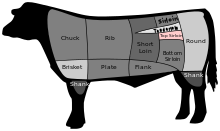| Part of a series on |
| Steak |
|---|

Top sirloin is a cut of beef from the primal loin or subprimal sirloin. Top sirloin steaks differ from sirloin steaks in that the bone and the tenderloin and bottom round muscles have been removed; the remaining major muscles are the gluteus medius and biceps femoris (top sirloin cap steak).
YouTube Encyclopedic
-
1/3Views:6 62712 02469 510
-
Cutting and Separating the Top Sirloin
-
How to home butcher a beef top sirloin butt
-
Cooking Sirloin Steak with Sandy Crombie
Transcription
Description
The USDA NAMP/IMPS codes related to this subprimal cut are 181A and 184. 181A is obtained from 181 after removing the bottom sirloin and the butt tender (the part of the tenderloin which is in the sirloin). 184 is obtained from 182 after removing the bottom sirloin. The food service cuts from 184 are 184A through 184F, its portion cut is 1184 and, the "subportion" cuts from 1184 are 1184A through 1184F. 181A is not further divided into food service cuts.[1] In Australia, this cut is called D-rump in the Handbook of Australian Meat and assigned code 2100.[2]
Etymology
The word comes from the Middle English surloine, which itself was derived from the Old French word surlonge, meaning sur longe or above the loin.[3] In Modern French, the term evolved to become aloyau or faux-filet.[4]
An often quoted false etymology suggests that sirloin comes from the knighting by an English king (various kings are cited) of a piece of meat.[5][3] However, the English cut of sirloin includes the large portion of beef which includes the short loin, top sirloin and bottom sirloin.
Cooking styles
Top sirloin steak is usually served grilled, broiled, sautéed, or pan-fried.
See also
References
- ^ "FRESH BEEF SERIES 100". Archived from the original on 2014-08-06. Retrieved 2015-04-06.
- ^ "Boneless Beef: D-Rump - 2100". Handbook of Australian Meat 7th Edition. Aus-Meat Limited. 2006. Archived from the original on 14 April 2014. Retrieved 8 September 2020.
- ^ a b Harper, Douglas. "sirloin (n.)". Online Etymology Dictionary. Retrieved 2015-04-06.
- ^ "sirloin". WordReference.com. Retrieved 8 September 2020.
- ^ Mikkelson, David (20 May 2001). "Etymology of Sirloin". Snopes.com. Retrieved 8 September 2020.
External links
- Chart of beef cuts
- Top sirloin description from Certified Angus Beef
- Bovine myology & muscle profile



